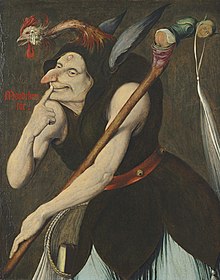Folly (allegory)


Folly (
Atë
.
In drama, the character tempts the protagonist into foolish action, successfully or not. In an allegorical painting, the figure may be counterpoised to Prudence, representing a choice, or alone, representing the unwisdom of the actors in the painting.
See also
- In Praise of Folly; the article contains an allegoric drawing of Folly
- Agnolo Bronzino
Notes
- ^ Mackay, Constance D'Arcy (1915). Costumes and Scenery for Amateurs. Henry Holt and Company. p. 197.
References
ed. A.W. Ward; A.R. Waller; W.P. Trent; J. Erskine; S.P. Sherman & C. Van Doren. "Sir David Lyndsay". The Cambridge history of English and American literature: An encyclopedia in eighteen volumes. Vol. III. {{cite book}}: |author= has generic name (help)
